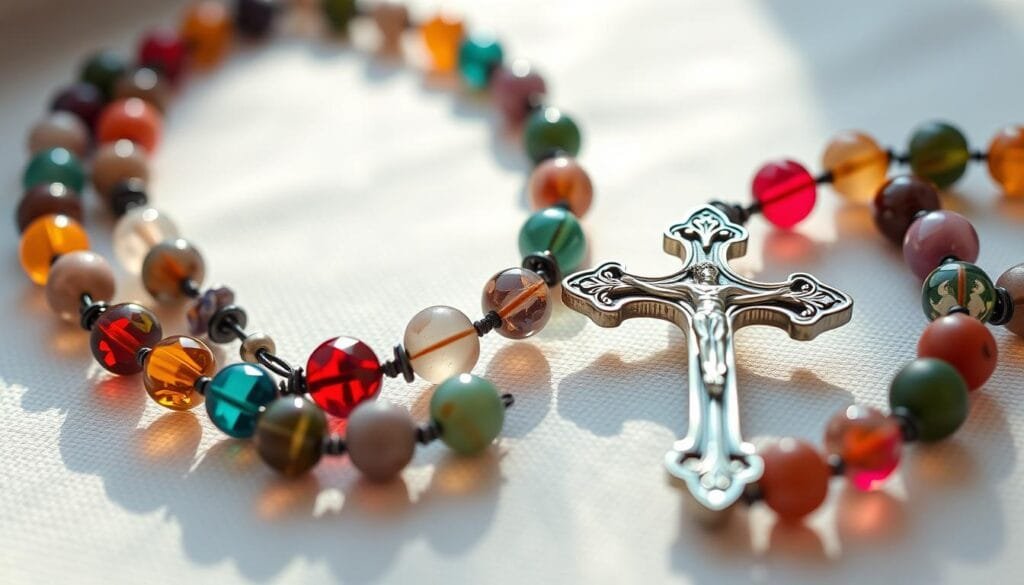Popular Catholic Chaplet Prayers
This website contains affiliate links. As an Amazon Associate, I earn from qualifying purchases. The content on this website was created with the help of AI.
Did you know over 70% of Catholics in the United States use chaplet prayers to deepen their faith?
The Divine Mercy Chaplet is a favorite among them. We’ll dive into the world of chaplet prayers, including the Divine Mercy Chaplet. You’ll learn how to pray them.
Key Takeaways
- We will explore the history and significance of catholic chaplet prayers, including the divine mercy chaplet.
- Learn how to pray popular catholic chaplets, such as the Chaplet of the Blessed Sacrament and the Chaplet of the Sacred Heart.
- Discover the benefits of incorporating catholic chaplet prayers into your daily prayer life.
- Understand the different types of prayer beads used in catholic chaplet prayers, including the rosary beads used in the divine mercy chaplet.
- Find out how catholic chaplet prayers can help you seek the intercession of saints and create a more focused prayer experience.
- Learn about the various chaplets that honor the Virgin Mary, such as the Chaplet of Our Lady of Czestochowa and the Chaplet of Our Lady, Star of the Sea.
- Explore the role of the Holy Spirit Chaplet in fostering a connection with the Holy Spirit and the Gifts of the Holy Spirit.
Understanding Catholic Chaplet Prayers in Our Faith
We often find ourselves drawn to various chaplets as a way to deepen our devotion and connection with our faith.
These chaplets, often used with prayer beads, provide a unique and meaningful way to pray and reflect on our beliefs.
One of the key aspects of Catholic chaplet prayers is their ability to help us focus on specific intentions and prayers.
By using prayer beads, we can keep track of our prayers and stay focused on our devotions. This can be helpful during times of reflection and contemplation, like during the Easter season.
As we explore the world of Catholic chaplet prayers, we begin to understand their significance.
From the Divine Mercy Chaplet to other various chaplets, each one offers a unique perspective on our faith and our relationship with God.
By incorporating these chaplets into our daily prayer life, we can deepen our understanding of our faith and our connection with the divine.
Some common elements found in Catholic chaplets include the use of prayer beads, specific prayers and intentions, and a focus on the life and teachings of Jesus.
By examining these elements, we can gain a deeper appreciation for the role of chaplets in our faith and how they can enrich our spiritual lives.
The Divine Mercy Chaplet: Our Most Beloved Prayer
The divine mercy chaplet brings us comfort. It was given to St. Faustina Kowalska, a Polish nun. This prayer helps us understand God’s endless mercy and the need for repentance.
To pray it, we use prayer beads. These guide us through prayers like the Our Father and the Hail Mary.
The chaplet has a special sequence of prayers. We repeat certain phrases many times. For example, “O Blood and Water, which gushed forth from the Heart of Jesus as a fountain of Mercy for us, I trust in you!”
Praying the chaplet involves reciting specific prayers on different prayer beads. We also offer the Body and Blood of Jesus Christ for our sins.

Here are the key aspects of the divine mercy chaplet:
- Seeking mercy from God for oneself and the whole world
- Reciting specific prayers on different prayer beads
- Emphasizing the importance of repentance and the transformative power of grace
The divine mercy chaplet is based on St. Faustina Kowalska’s teachings. It’s a key part of Catholic devotion to divine mercy. We suggest praying it daily, at 3 pm, to grow in faith and hope.
Sacred Prayer Beads: Tools for Deeper Devotion
Prayer beads are key in our Catholic devotion. They help us pray various chaplets and remind us of our faith. In the U.S., they’re mainly used by Catholics.
But they’re also popular among Eastern Orthodox Christians and some Protestants.
Prayer beads help us focus on God. They make our prayers more meaningful. The tradition of using them started in Christian Egypt around AD 300 to 350.
Different Types of Prayer Beads
There are many types of prayer beads, each with its own meaning. For instance, the Chaplet of the Blessed Sacrament has 33 beads.
It symbolizes Christ’s 33 years on earth. Pope Pius X approved it on May 30, 1911.
Proper Care and Blessing of Prayer Beads
It’s important to take care of and bless our prayer beads. Many Catholics have theirs blessed by a priest. This act makes them even more special.
Understanding prayer beads and chaplets helps us grow closer to God. Whether it’s a traditional rosary or a chaplet, these beads remind us of our faith. They help us stay focused on God.
| Type of Prayer Beads | Number of Beads | Symbolism |
|---|---|---|
| Chaplet of the Blessed Sacrament | 33 | 33 years of Christ’s life on earth |
| Rosary | 59 | Mysteries of the Rosary |

Most Popular Chaplets in American Catholic Tradition
We often find comfort in various chaplets that have been a part of our Catholic heritage. The Chaplet of Divine Mercy, Chaplet of Saint Joseph, and Holy Spirit Chaplet are highly revered.
Each catholic chaplet prayer serves a unique purpose, like invoking divine mercy or seeking guidance.
These chaplets unite us with the Universal Church and give our prayers a purpose. For example, the Chaplet of Saint Joseph honors his virtues.
The Holy Spirit Chaplet helps us seek divine inspiration. The Chaplet of the Holy Souls in Purgatory aids souls undergoing purification.
Popular chaplets in the American Catholic tradition include the Little Flower Rosary and Chaplet of St. Gerard.
Catholic chaplet prayers can make our novena practice more meaningful. By aligning our intentions with the chaplet’s purpose, we can experience a structured devotional experience.
Chaplets can be made using knotted twine or rosary beads. Resources are available on websites like rosaryarmy.com and rosarymakersguide.org.
Saint medals for devotions can be found on sites like totallycatholic.com. Exploring catholic chaplet prayers helps us understand their significance and role in our faith.
Spiritual Benefits of Praying with Chaplets
Exploring Catholic devotions, we see chaplets deeply impact our spiritual lives. The divine mercy chaplet and others draw us closer to God.
They help us bond with saints, leading to peace and tranquility.
Praying with chaplets boosts mental and emotional health. The divine mercy chaplet‘s repetition calms the mind, easing stress and anxiety. Prayer beads offer a physical link to faith, aiding focus.
- Begin with a chaplet, like the divine mercy chaplet, for a positive start
- Use prayer beads to guide your prayers and thoughts
- Turn to chaplets in stressful times, like before surgery, for comfort
Embracing chaplets’ spiritual benefits can deepen our faith. Whether it’s the divine mercy chaplet or others, the goal is to pray with an open heart. This allows prayer to change our lives.
Conclusion: Enriching Our Faith Through Chaplet Prayers
As we wrap up our look at Catholic chaplet prayers, it’s clear they have a special power. They can make our faith stronger and our bond with God deeper.
By adding various chaplets to our daily prayers, we can see big changes in our spiritual lives.
Chaplets are a special way to grow spiritually. They let us think deeply about our faith and get closer to God.
The rhythm of praying and the feel of prayer beads bring us peace, clarity, and purpose.
Whether it’s the Divine Mercy Chaplet or other Catholic chaplet prayers, each one can change our lives in big ways.
By making chaplets a regular part of our prayer, we learn to love our Catholic tradition more. We also gain wisdom that lasts forever.
Let’s keep using chaplet prayers to grow personally and together. They help us find a more meaningful faith. May these prayers keep inspiring, uplifting, and guiding us closer to God’s heart.










